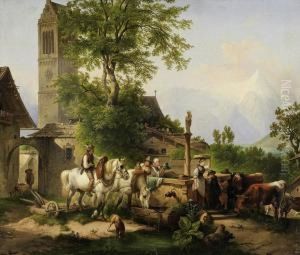Karl Schwenninger Paintings
Karl Schwenninger was an Austrian painter known for his genre paintings, landscapes, and portraits. Born on September 7, 1854, in Vienna, Austria, he grew up in the cultural ambiance of the Austro-Hungarian Empire, which was a significant center for arts and music during the 19th century. Schwenninger's father, Johann Schwenninger, was also a painter, which likely provided the younger Schwenninger with early exposure to the world of art.
Schwenninger received his formal art education at the Vienna Academy of Fine Arts, where he studied under the guidance of renowned artists such as Christian Griepenkerl and Karl von Blaas. During his time at the academy, Schwenninger honed his skills in various painting techniques and developed a style characterized by a keen attention to detail and a penchant for capturing the nuances of light and atmosphere.
After completing his education, Schwenninger embarked on a career as a professional artist. His works often depicted idyllic scenes of the Austrian countryside, as well as the daily lives of its inhabitants. He had a particular interest in capturing the changing seasons and the ways in which they transformed the landscape. In addition to his landscapes, Schwenninger also produced a number of portraits, showcasing his ability to capture the essence of his subjects with sensitivity and depth.
Schwenninger's paintings were well-received during his lifetime, and he participated in numerous exhibitions across Europe. His works were appreciated for their romanticized view of rural life and their technical proficiency. Despite his success, Schwenninger's life was relatively short, and he passed away on October 15, 1903, in his hometown of Vienna at the age of 49.
Today, Karl Schwenninger's paintings are held in various private collections and museums. While he may not be as widely recognized as some of his contemporaries, his contributions to the Austrian art scene of the late 19th century remain appreciated by art historians and collectors. His work stands as a testament to the bucolic beauty of the Austrian landscape and the enduring appeal of genre painting.
